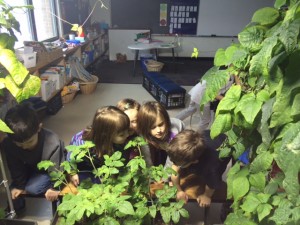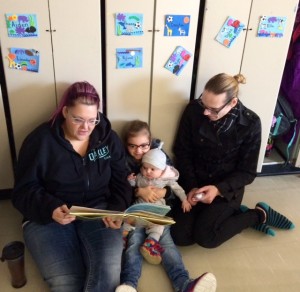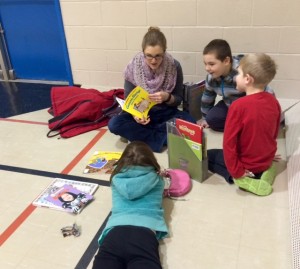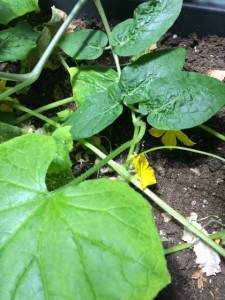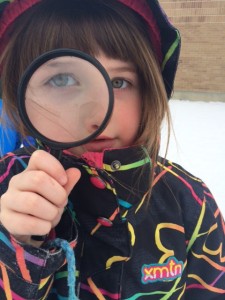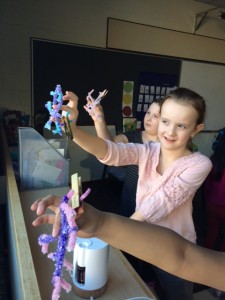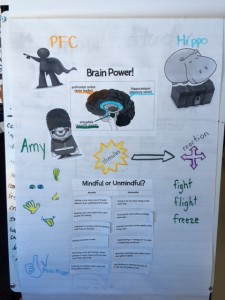Welcome to February!
February is going to fly by as we pass the 100th day of school mark next week, celebrate friendship near Valentines day, and head into the February break. Check out the February Calendar to keep up to date on what’s going on this month.
Thank you to everyone who came out to Cuddle Up and Read with us last week! It was a very cozy and very fun start to the day, with pockets of families and friends absorbed in reading in every nook in the school.
What’s New In Our Classroom?
We have had three bean harvests and are spotting lots of yellow blossoms on our cucumbers and tomato plants. Soon we will need to help pollinate the tomato flowers to make sure we get lots of tasty tomatoes to snack on with our basil!
After starting a study of animals in winter, then realizing that our little geniuses already know lots and lots about that topic, we have started a fun inquiry project we’re calling “Snow Study”. It will give us a chance to investigate the daily and seasonal changes that are all around us, to look closer what goes on outside while we snuggle up inside in the winter, and to learn how to make and test a hypothesis as we complete fun and exciting experiments!
Flashlight Fridays: For the month of February, students will be invited to bring a personal flashlight each Friday for some fun reading activities. What’s more fun than reading? Reading with a flashlight, at school, with the lights off, and feeling super sneaky and super cozy at the same time. I’ll have a few extras for those students who aren’t able to bring a flashlight. Check out what others have been saying about #flashlightfriday on Twitter!
The 100th Day of School: It’s coming up folks! We’ll be celebrating the 100th day of school on Thursday, February 11th. This year we’re celebrating a super 100 days of school with a superhero theme! Counting to 100 may be tricky, but a superhero can do it, right? We’ll be superheroes for the day with the power of 100 behind us. At the end of this week, your child will receive a homework challenge which is due on Thursday, February 11th. Don’t worry, it’s a fun one! The challenge is to make a 100 cape (capes supplied) by gluing or sticking 100 things onto your cape. Read the letter that comes home with the cape for some ideas. A tip? Count the 100 objects out in 10 groups of 10, then count by 10s to get to 100! Another tip? Check out these awesome 100 day capes from Mrs. Miner’s class:
If you can’t find 100 things to glue, how about drawing them instead? Students should wear their 100 Day Superhero cape to school on February 11th for a super 100th day of school!
Toys: Some students have been bringing a large amount of toys to school which is proving to be a bit distracting. Though students are allowed to show one toy at circle time before putting it away in their backpacks, there are many times during the day where those same toys (or two, three, or six) make there way onto tables and into laps during learning times. Please try to remind your child to bring one toy only, and to keep it in their backpack unless it’s recess time. Students who are being quite distracted by bringing toys may be asked not to bring them anymore. Thanks for your help!
Mind Up: We talk every day about “mindfulness” and how we can help our brains learn to react to the things that happen around us in “mindful” ways. We’ve learned that our Hippocampus (the “Hippo”) is our memory saver. It’s where our brain builds pathways as we learn. The more pathways we can build, the more we learn and the better we remember! We’ve learned that our pre-frontal cortex (the “PFC”) is our wise leader. It’s the part of our brain that helps us to make good, mindful decisions. We’ve learned that our amygdala (the “Amy”) is our security guard. It’s the part of our brain that tells us to “fight, flight or freeze” when we sense danger.
That “Amy” can be a tricky thing, though, because sometimes it senses danger, even if we’re not in danger. For example, if someone bumps into you in the recess line up, your “Amy” might sense danger and tell you to fight the person who bumped you, even if it was an accident. So now we’re practicing how to use breathing techniques, our five senses, and powerful thinking to help give our “PFC” more time to take charge so that our “Amy” isn’t in control all the time. Gotta love that wise leader, the “PFC”! We’ve learned that if someone bumps into you in the line up, for example, one of the best things your “PFC” can lead you to do is to ask questions, such as “Why did you just bump me?” or “Did you realize you just bumped me?” to avoid fighting or blaming.
Important Assessment News
Our school has been selected to participate in the pilot project for a new holistic Ministry of Education assessment task called Help Me Talk About Math, a partner to the language arts Help Me Tell My Story assessment piloted in the last couple of years. You can read all about the assessment by clicking this link. From the ministry’s website:
Help Me Talk About Math uses a new, holistic approach to measure a child’s deeper understanding of mathematics and to promote ways that caregivers, Elders and others can talk to children about math each and every day. In order to provide a holistic view of each child’s learning, the application collects data from the children, their caregivers, their teachers and Elders in their community. It is a formative assessment that provides an understanding of a child’s “deeper understanding” of mathematical processes such as visualization, estimation, mental math, problem solving, communicating strategies, and making connections to the world. (holisticassessment.gov.sk.ca)
Before beginning the assessment, through story telling and an engaging puppet, the children are introduced to a character named Aski (the Cree word for “Earth”) and some of his forest friends, who later create the familiar context for the assessment. The assessment is conducted by having students interact with an iPad to answer questions about their experiences with math, complete tasks to show their understanding of mathematical processes, and record explanations of their thinking. From the results teachers and caregivers can learn how to move each child forward to help them deepen their mathematical understanding and enrich their mathematical experiences.
Teachers and caregivers are also asked to complete a survey on the iPad to help create a holistic picture of each child’s mathematical experiences. Caregivers will later be able to log in to the website to view their child’s results and have access to a number of learning activities and ideas for how to enrich math experiences for children outside of school.
This is where we need your help! We would like to collect all of the survey data from caregivers, teachers and students before the February break. The survey for caregivers takes about 5 minutes to complete on one of our iPads at school. If you are able, please find a moment to drop into the school between 8:30 am and 3:37 pm by February 12th. Mrs. Bosch will be prepared in the office with two school iPads and instructions for you to complete the survey. Thank you for helping us to understand what our kids know about math!
Spotlight on Numeracy
We’re adding every day, and currently we’re adding doubles. It’s important for students to develop automaticity with these basic facts (with sums up to 12) to make more complex addition easier later. We build addition sentences with various tools, roll them with dice, slice them into parts, and record them with our pencils over and over again in our math journals. Here’s a doubles poem we’ve been using to help us visualize the doubles facts:
Have you ever stopped to think about what your brain is doing when you do math? As important as it is for students to know basic math facts automatically, it’s greatly important for them to develop skills in six key processes with the help of explicit teaching, technology, and practice, practice, practice. These six mathematical processes are:
Visualizing (“See it”) – students progress from needing to see and using objects to do math (like counters or blocks), to using a combination of pictures and objects (like counting on a number line or drawing dots on their paper), to being able to see the math in their head, like picturing those objects and tools that they used to need to use concretely.
Communication (“Say it”) – Students progress from talking about math only with adult support to being able to talk about math using every day, familiar words to being able to talk about math using specific math language (such as “sum”, “difference” “more” “less”) and symbols.
Connections (“Link it”) – Students grow more and more aware of how math links to other activities and real-life applications. Students make math-to-self connections (“Hey, I see the number 6, that’s how old I am!”), math-to-world connections (“I know a Shopkin costs $5 and I have $10, 5 + 5 = 10 so I can buy TWO Shopkins!”), and math-to-math connections (“I know 5 + 5 is 10, so 5 + 6 must be 11”).
Mental Math and Estimation (“Think it”) – Students recognize quantities at a glance (subitize) by seeing groups of numbers and knowing how they fit together (“I know that’s 9 dots because I see 3 rows of 3”), can make a reasonable estimates based on what they already know (“If 10 jellybeans looks like this, I think there are about 4 groups of 10 jellybeans, so I think there are about 40”), and start to solve math problems in their head, without the use of tools or aids.
Problem Solving (“Solve it”) – Students learn how to pick out important information in a math problem, choose a strategy for solving the problem, and come up with a reasonable solution.
Reasoning (“Explain it”) – Students can explain or show how they arrived at a reasonable solution.
We’ll be working on grade one versions of these mathematical processes to become awesome thinkers and problem solvers!
Communication
Please remember that I am happy to chat about questions, concerns, celebrations, or clarifications with you at any time! The best way to reach me is by email, at morgan.herbison@rbe.sk.ca. Writing a note in the agenda is an option as well. We have started to use our Twitter account more frequently. Checking this can be a great antidote to those moments when you ask your child, “What did you do at school today?”, and they reply “nothing”. We’ll be posting a few things that we were up to whenever we get the chance. Remember, even if you don’t use Twitter yourself, you can still visit www.twitter.com/herbiesclass to check it out!

